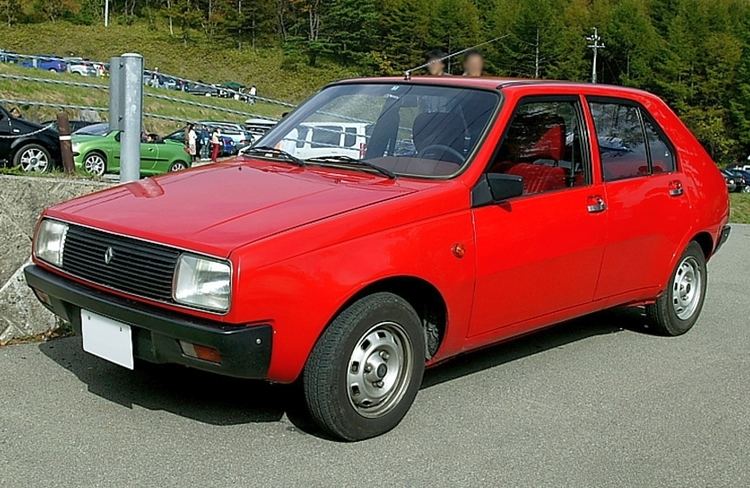Class Small family car (C) Layout FF layout | Production 1976-1983 | |
 | ||
Assembly Douai, FranceHaren, Belgium | ||
The Renault 14 is a compact car produced by the French manufacturer Renault between 1976 and 1983. It was first shown in January 1976 with production beginning in June of that year.
Contents
It was the first car to be produced in large volumes at the company's then new plant at Douai, although small pilot runs of the Renault 5 had preceded the 14's production in the factory.
History
Featuring front wheel drive, the 14 was developed to compete in the small family hatchback sector, which had been popularized by the launch of the Volkswagen Golf in 1974. Initially, the 14 was available in L and TL trim levels with a 1.2 L single overhead camshaft engine and later 1.4 L versions with 60 PS (44 kW; 59 hp) (R14 GTL) or 70 PS (51 kW; 69 hp) (R14 TS) joined the line-up. Both units were the X-type engine (commonly known as the "Douvrin" or "Suitcase Engine") jointly developed with Peugeot, although the 14 turned to be the only Renault vehicle that used the unit. The design was generally well thought out and practical with interior space a major selling point, including a rear seat that could either be folded or removed completely. In addition, the spare wheel was carried at the front, under the bonnet and above the transverse 4-cylinder engine that was inclined backwards by 72°. Although all Renault cars were by now front wheel drive, the 14 was the first of the manufacturer's models to incorporate a space saving Mini-like transversely mounted engine. The exterior styling of the Renault 14 was praised by the motoring press as being fresh and ahead of its time and many have drawn a parallel between it and the later Peugeot 205.
The 14 shared with several previous Renault models a rear suspension system using two full-width torsion bars positioned one behind the other, along with the resulting wheelbase difference of more than 1 inch (32 mm) between the left and right sides of the car.
For 1979 Renault sought to compensate for a slow start in the marketplace, widening the range upmarket with a "GTL" version of the car taking its wheels and some other ornaments and interior styling cues from the newly launched Renault 18, and a "TS" with twin chamber carburetor and claimed power raised from 57 hp (43 kW) to 70 hp (52 kW). In Renault 14 TS new Halogen "H4" lights brightened the way ahead after dark, and showroom appeal was enhanced with electric windows in the front, which was a first for this class of car in the French market.
The Renault 14 may have been one of the first front-wheel drive hatchbacks of its size to be produced in Europe, but within four years of its launch it was facing fierce competition from a growing number of similar products from rival manufacturers, particularly the Ford Escort MK3, Opel Kadett (Vauxhall Astra in the UK), Fiat Ritmo/Strada and Talbot Horizon. It was joined in the Renault range by the award-winning Renault 9 in 1981, the car which spawned the Renault 14's direct successor (the Renault 11) two years later.
"The Pear"
Things got off to a bad start with a disastrous advertising campaign that compared the 14 to the shape of a pear. A preview at the Pompidou Centre in Paris as a bare bodyshell did little to win it customers. The car would later gain a reputation for premature body corrosion which saw the 14 being dubbed as the "rotten pear" by the motoring press. In France, "La poire"' (literally "the pear", but also slang for "gullible") still refers to the 14. However, the best-selling Renault 5 also had a reputation for premature body corrosion, but the stronger and more adequate advertising of the R5 helped boost its sales and resulted in it being a sales hit.
The car also had a reputation for being difficult to start in damp conditions. The placement of the temperature gauge on the transmission tunnel behind the gear-lever, rather than on the instrument panel where it was directly in the driver's field of view, led to incidents of engine damage if the engine overheated and the driver failed to notice.
Relaunch
For 1980 Renault attempted to improve sales by relaunching the car with improved equipment levels and a minor facelift that included, most obviously from the outside, repositioned front indicators. But the damage was done and the production run ended in 1983 with precisely 993,193 units sold over a period of just under seven years. Initial production was 325 cars per day, which had been scheduled to increase to 700 in 1977 and to nearly 1,000 in 1978. This never materialized, as sales peaked very early in the R14's life. Sales in the domestic French market did improve somewhat with the redesign. The 14 is now a rare sight on the roads of Europe, even in its home country of France where they have tended to last longer than elsewhere due mainly to easy parts availability through the extensive dealer network. Many Renault 14s were used by the French police in the 1980s.
Its joint successors, the 9 and 11 appeared in 1981 and early 1983, respectively. The front end of the pre-facelift Renault 9 looked similar to the front end of the post-facelift Renault 14. However, both the Renault 9 and 11 had more conservative exterior body styling.
